The Prediction of Spark-Ignition Engine Performance and Emissions Based on the SVR Algorithm
Abstract
:1. Introduction
2. Data Collection and ML Modeling
2.1. Experimental System
2.2. SVR Algorithm
2.3. The Model Training Process
3. Results and Discussion
3.1. Discussion of Indicated Specific Fuel Consumption and Emissions Prediction
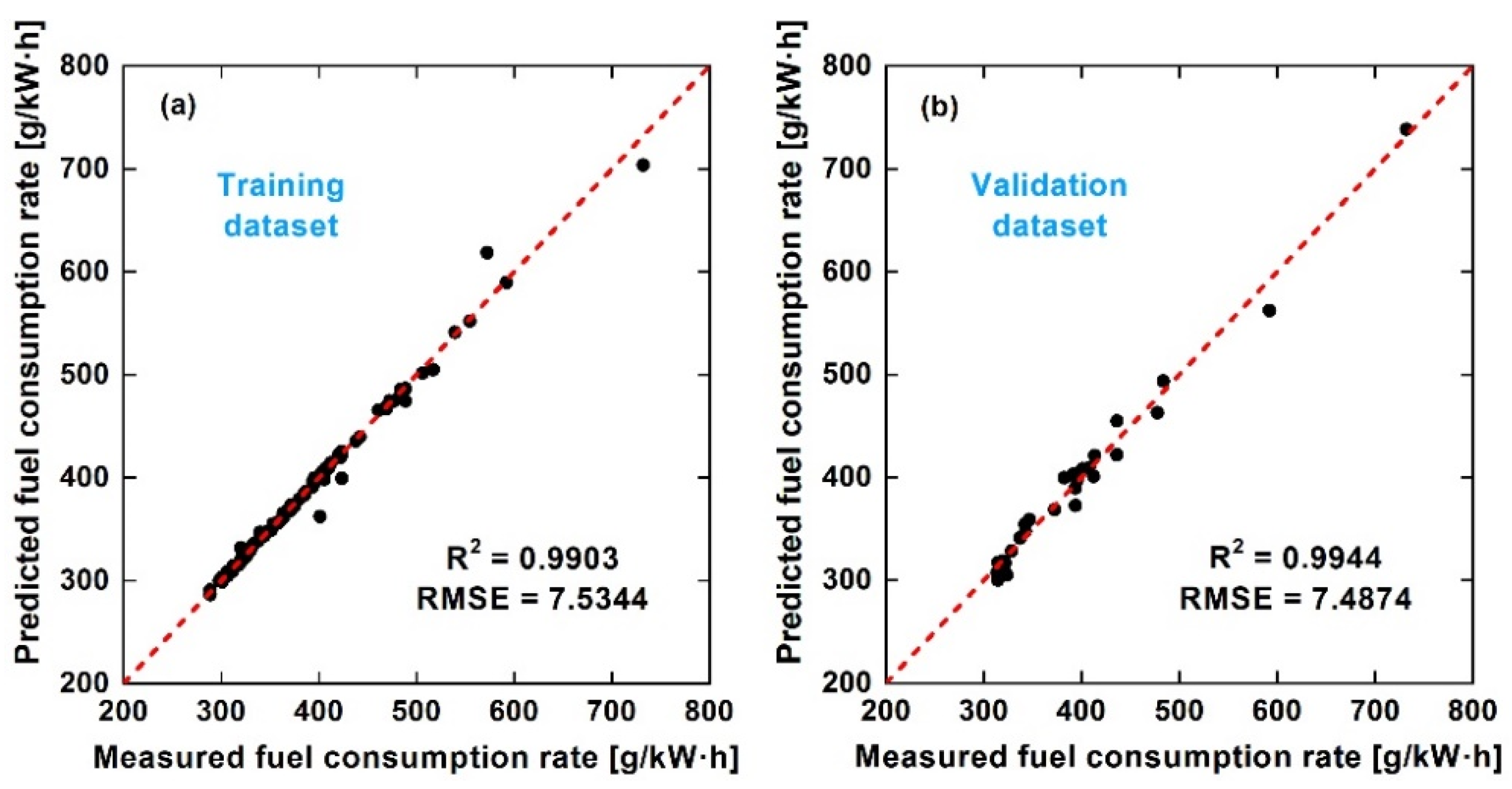
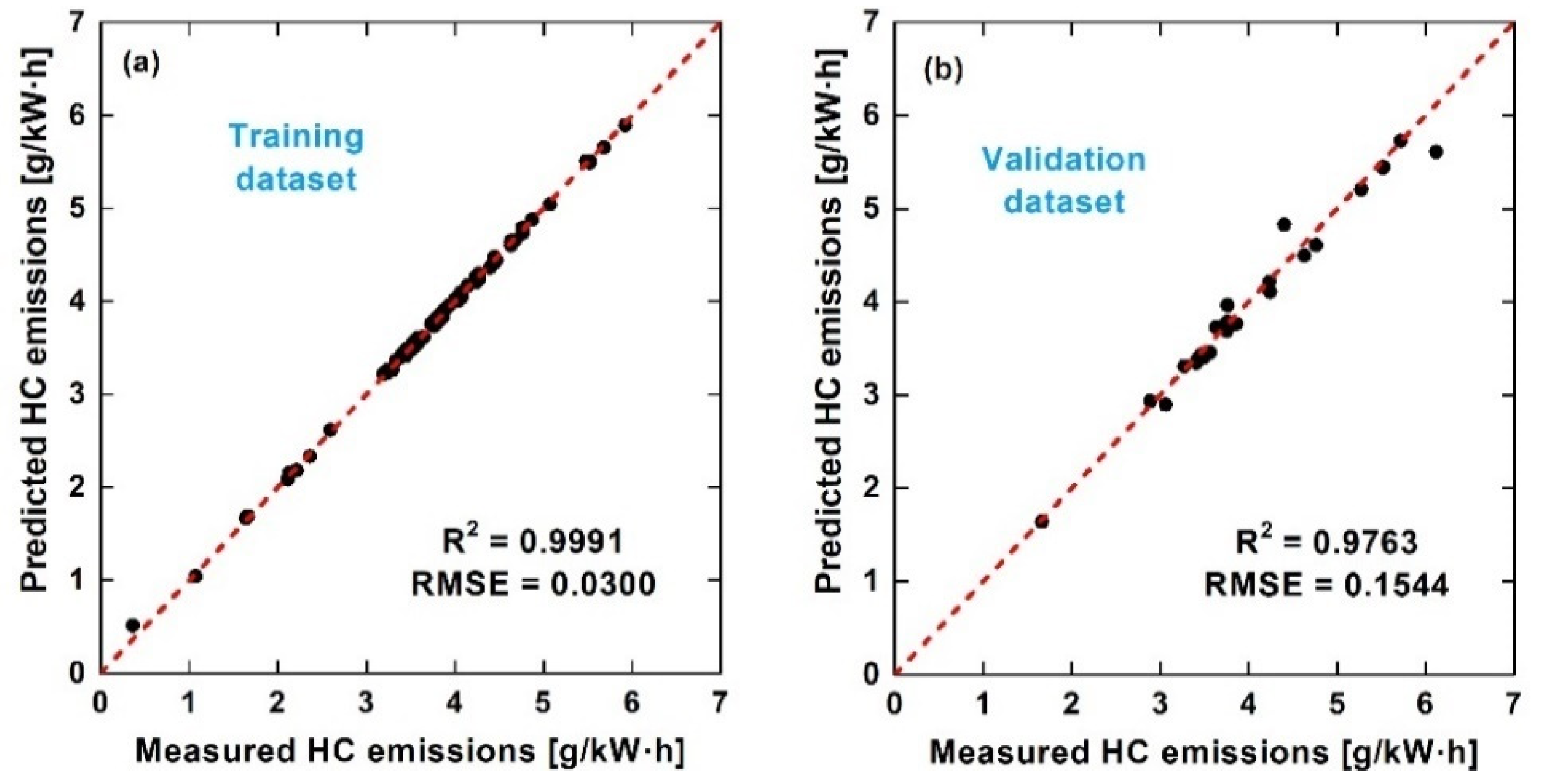

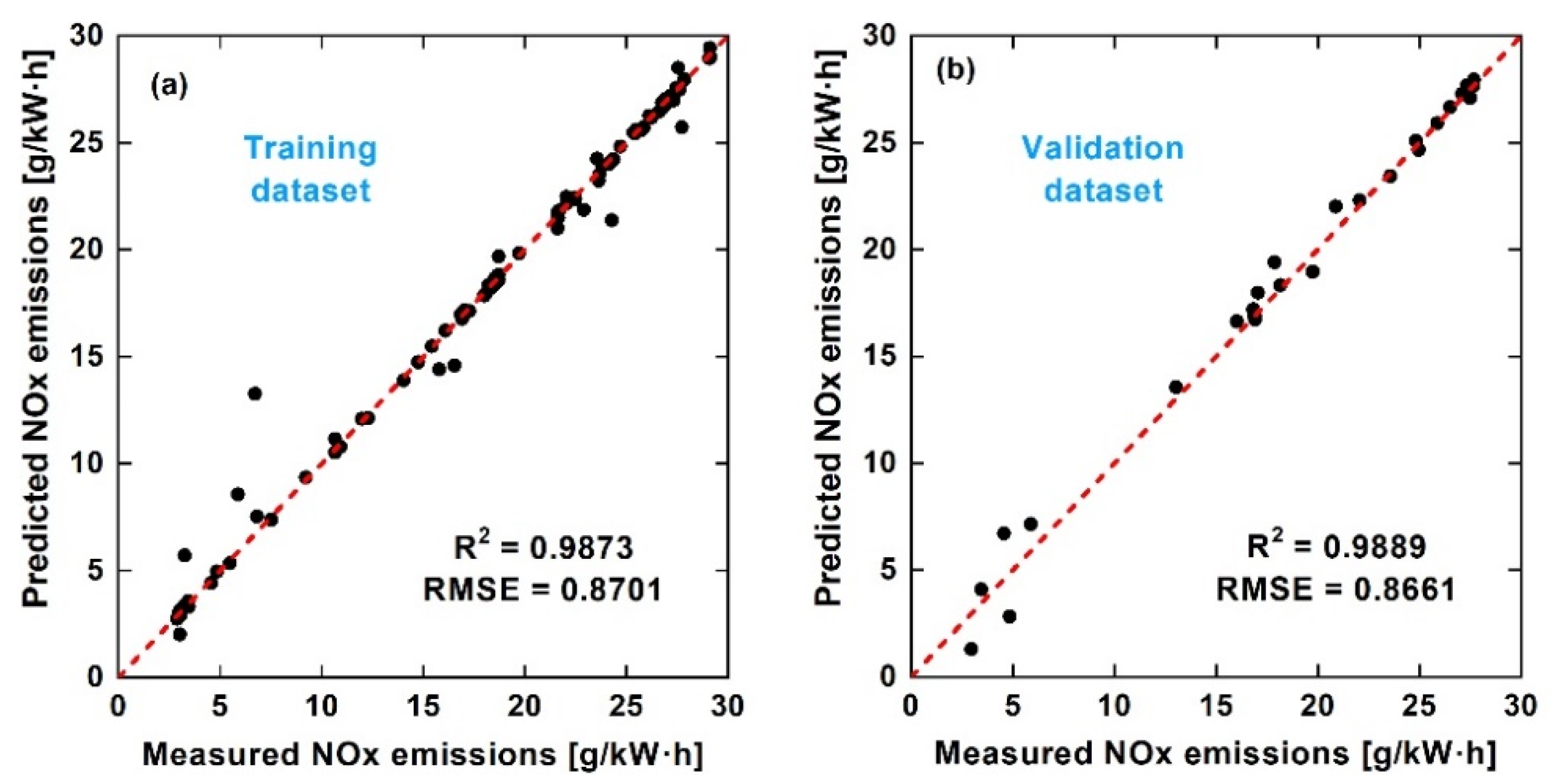
3.2. Discussion of Steady-State Prediction
3.3. Discussion of Engine Performance Map Prediction
4. Conclusions
- (1)
- Our previous research found that artificial neural networks can help predict engine performance and emissions, at least for the gasoline engine discussed in this study. However, it required heavy tuning of the hyperparameters, such as the net structure. In contrast, the SVR algorithm employed in this study had a more convenient tuning process during the supervised learning process. Moreover, model performance regarding the training and validation datasets was improved. As a result, the SVR algorithm was suitable to be used for engine combustion-related parameters forecasting. In addition, the SVR model can help establish the engine mapping because the algorithm well correlated the engine control variables and engine responses, which can help reduce the effort during engine development.
- (2)
- As for the engine response prediction performance, fuel consumption rate and NOx emissions were predicted with good accuracy, while HC and CO emissions were predicted with a little less accuracy, compared with the first two. The underlying reason was the nature of the engine response. Specifically, HC emissions were unevenly distributed because HC concentration mainly depended on the trapped mass inside the crevice. With respect to CO emissions, variation in the equivalence ratio would dramatically change the CO concentration. This was because there is an order of magnitude difference in CO concentration between lean and rich combustion. Small changes in the equivalence ratio of the stoichiometry control would result in large changes in CO emission levels, making model predictions difficult. As a result, the combination of machine learning and carbon balance has the potential to further improve the performance of incomplete combustion production concentration predictions if carbon dioxide can be well forecasted, which will be the future direction of this study.
Author Contributions
Funding
Institutional Review Board Statement
Informed Consent Statement
Data Availability Statement
Acknowledgments
Conflicts of Interest
References
- Stocchi, I.; Liu, J.; Dumitrescu, C.E.; Battistoni, M.; Grimaldi, C.N. Effect of Piston Crevices on the Numerical Simulation of a Heavy-Duty Diesel Engine Retrofitted to Natural-Gas Spark-Ignition Operation. J. Energy Resour. Technol. 2019, 141, 112204. [Google Scholar] [CrossRef]
- Dumitrescu, C.E.; Padmanaban, V.; Liu, J. An Experimental Investigation of Early Flame Development in an Optical Spark Ignition Engine Fueled with Natural Gas. J. Eng. Gas Turbines Power. 2018, 140, 082802. [Google Scholar] [CrossRef]
- Bommisetty, H.; Liu, J.; Kooragayala, R.; Dumitrescu, C. Fuel Composition Effects in a CI Engine Converted to SI Natural Gas Operation (No. 2018-01-1137). SAE Tech. Pap. 2018, 1–8. [Google Scholar] [CrossRef] [Green Version]
- Huang, Q.; Bhattacharyya, D. Optimal Sensor Network Design for Multi-Scale, Time-Varying Differential Algebraic Equation Systems: Application to an Entrained-Flow Gasifier Refractory Brick. Comput. Chem. Eng. 2020, 141, 106985. [Google Scholar] [CrossRef]
- Schafer, F.; Schäfer, F.; Van Basshuysen, R. Reduced Emissions and Fuel Consumption in Automobile Engines; Springer Science and Business Media: Berlin/Heidelberg, Germany, 1995. [Google Scholar]
- Liu, J.; Ulishney, C.; Dumitrescu, C.E. Predicting the Combustion Phasing of a Natural Gas Spark Ignition Engine Using the K-Nearest Neighbors Algorithm. In Proceedings of the ASME International Mechanical Engineering Congress and Exposition, Virtual Conference, 16–19 November 2020. [Google Scholar] [CrossRef]
- Akgül, A. A Novel Method for a Fractional Derivative with Non-Local and Non-Singular Kernel. Chaos Solitons Fractals 2018, 114, 478–482. [Google Scholar] [CrossRef]
- Akgül, A.; Karatas Akgül, E. A Novel Method for Solutions of Fourth-Order Fractional Boundary Value Problems. Fractal Fract. 2019, 3, 33. [Google Scholar] [CrossRef] [Green Version]
- Akgül, E.K.; Akgül, A.; Yavuz, M. New Illustrative Applications of Integral Transforms to Financial Models with Different Fractional Derivatives. Chaos Solitons Fractals 2021, 146, 110877. [Google Scholar] [CrossRef]
- Akgül, A.; Akgül, E.K.; Baleanu, D.; Inc, M. New Numerical Method for Solving Tenth Order Boundary Value Problems. Mathematics 2018, 6, 245. [Google Scholar] [CrossRef] [Green Version]
- Kılıcman, A.; Khan, Y.; Akgul, A.; Faraz, N.; Akgul, E.K.; Inc, M. Analytic Approximate Solutions for Fluid Flow in the Presence of Heat and Mass Transfer. Therm. Sci. 2018, 22 (Suppl. 1), 259–264. [Google Scholar] [CrossRef] [Green Version]
- Heywood, J.B. Internal Combustion Engine Fundamentals; McGraw-Hill Education: Ney York, NY, USA, 2018. [Google Scholar]
- Liu, J.; Dumitrescu, C. CFD Simulation of Metal and Optical Configuration of a Heavy-Duty CI Engine Converted to SI Natural Gas. Part 2: In-Cylinder Flow and Emissions (No. 2019-01-0003). SAE Tech. Pap. 2019, 1–8. [Google Scholar] [CrossRef]
- Liu, J.; Dumitrescu, C. CFD Simulation of Metal and Optical Configuration of a Heavy-Duty CI Engine Converted to SI Natural Gas. Part 1: Combustion Behavior (No. 2019-01-0002). SAE Tech. Pap. 2019, 1–8. [Google Scholar] [CrossRef]
- Liu, Z.; Zuo, Q.; Wu, G.; Li, Y. An Artificial Neural Network Developed for Predicting of Performance and Emissions of a Spark ignition Engine Fueled with Butanol–Gasoline Blends. Adv. Mech. Eng. 2018, 10, 1687814017748438. [Google Scholar] [CrossRef]
- Ambrogi, L.; Liu, J.; Battistoni, M.; Dumitrescu, C.; Gasbarro, L. CFD Investigation of the Effects of Gas’ Methane Number on the Performance of a Heavy-Duty Natural-Gas Spark-Ignition Engine. SAE Tech. Pap. 2019. [Google Scholar] [CrossRef]
- Sui, W.; Hall, C.M. Combustion Phasing Modeling and Control for Compression Ignition Engines with High Dilution and Boost Levels. Proc. Inst. Mech. Eng. Part D J. Automob. Eng. 2018, 233, 1834–1850. [Google Scholar] [CrossRef] [Green Version]
- Liu, J.; Wang, H. Machine Learning Assisted Modeling of Mixing Timescale for LES/PDF of High-Karlovitz Turbulent Premixed Combustion. Combust. Flame 2022, 238, 111895. [Google Scholar] [CrossRef]
- Liu, J.; Ulishney, C.; Dumitrescu, C.E. Application of Random Forest Machine Learning Models to Forecast Combustion Profile Parameters of a Natural Gas Spark Ignition Engine. In Proceedings of the ASME International Mechanical Engineering Congress and Exposition, Virtual Conference, 16–19 November 2020. [Google Scholar] [CrossRef]
- Laubscher, R.; Rousseau, P. An Integrated Approach to Predict Scalar Fields of a Simulated Turbulent Jet Diffusion Flame Using Multiple Fully Connected Variational Autoencoders and MLP Networks. Appl. Soft Comput. 2021, 101, 107074. [Google Scholar] [CrossRef]
- Liu, J.; Ulishney, C.; Dumitrescu, C.E. Random Forest Machine Learning Model for Predicting Combustion Feedback Information of a Natural Gas Spark Ignition Engine. J. Energy Resour. Technol. 2021, 143, 012301. [Google Scholar] [CrossRef]
- Masikos, M.; Demestichas, K.; Adamopoulou, E.; Theologou, M. Energy-Efficient Routing Based on Vehicular Consumption Predictions of a Mesoscopic Learning Model. Appl. Soft Comput. 2015, 28, 114–124. [Google Scholar] [CrossRef]
- Deng, Y.; Zhu, M.; Xiang, D.; Cheng, X. An Analysis for Effect of Cetane Number on Exhaust Emissions from Engine with the Neural Network. Fuel 2002, 81, 1963–1970. [Google Scholar] [CrossRef]
- Liu, J.; Ulishney, C.; Dumitrescu, C.E. Comparative Performance of Machine Learning Algorithms in Predicting Nitrogen Oxides Emissions of a Heavy Duty Natural Gas Spark Ignition Engine. In Proceedings of the International Conference on Applied Energy, Bangkok, Thailand, 29 November–5 December 2020. [Google Scholar]
- Yusaf, T.F.; Buttsworth, D.; Saleh, K.H.; Yousif, B. CNG-Diesel Engine Performance and Exhaust Emission Analysis with the Aid of Artificial Neural Network. Appl. Energy 2010, 87, 1661–1669. [Google Scholar] [CrossRef]
- Liu, J.; Huang, Q.; Ulishney, C.; Dumitrescu, C.E. Prediction of Exhaust Gas Temperature of a Natural Gas Spark Ignition Engine Using Machine Learning Methods. In Proceedings of the International Conference on Applied Energy, Bangkok, Thaliand, 1–10 December 2020. [Google Scholar]
- Liu, J.; Huang, Q.; Ulishney, C.; Dumitrescu, C.E. Machine Learning Assisted Prediction of Exhaust Gas Temperature of a Heavy-Duty Natural Gas Spark Ignition Engine. Appl. Energy 2021, 300, 117413. [Google Scholar] [CrossRef]
- Parlak, A.; Islamoglu, Y.; Yasar, H.; Egrisogut, A. Application of Artificial Neural Network to Predict Specific Fuel Consumption and Exhaust Temperature for a Diesel Engine. Appl. Therm. Eng. 2006, 26, 824–828. [Google Scholar] [CrossRef]
- Liu, J.; Ulishney, C.; Dumitrescu, C.E. Improving Machine Learning Model Performance in Predicting the Indicated Mean Effective Pressure of a Natural Gas Engine. In Proceedings of the American Society of Mechanical Engineers Internal Combustion Engine Division Fall Technical Conference, Virtual Conference, 4–6 November 2020. [Google Scholar]
- Blurock, E.S.; Tuner, M.; Mauss, F. Phase Optimized Skeletal Mechanisms for Engine Simulations. Combust. Theory Model. 2010, 14, 295–313. [Google Scholar] [CrossRef]
- Chong, L.W.; Rengasamy, D.; Wong, Y.W.; Rajkumar, R.K. Load Prediction Using Support Vector Regression. In Proceedings of the IEEE International Joint Conference on Neural Networks, Penang, Malaysia, 5–8 November 2017; pp. 1069–1074. [Google Scholar] [CrossRef]
- Aliramezani, M.; Norouzi, A.; Koch, C.R. Support Vector Machine for a Diesel Engine Performance and NOx Emission Control-Oriented Model. IFAC—Pap. 2020, 53, 13976–13981. [Google Scholar] [CrossRef]
- Najafi, G.; Ghobadian, B.; Moosavian, A.; Yusaf, T.; Mamat, R.; Kettner, M.; Azmi, W.H. SVM and ANFIS for Prediction of Performance and Exhaust Emissions of a SI Engine with Gasoline–Ethanol Blended Fuels. Appl. Therm. Eng. 2016, 95, 186–203. [Google Scholar] [CrossRef] [Green Version]
- Liu, J.; Huang, Q.; Ulishney, C.; Dumitrescu, C. A Support-Vector Machine Model to Predict the Dynamic Performance of a Heavy-Duty Natural Gas Spark Ignition Engine. SAE Tech. Pap. 2021. [Google Scholar] [CrossRef]
- Rezaei, J.; Shahbakhti, M.; Bahri, B.; Aziz, A.A. Performance Prediction of HCCI Engines with Oxygenated Fuels Using Artificial Neural Networks. Appl. Energy 2015, 138, 460–473. [Google Scholar] [CrossRef]
- Niu, X.; Yang, C.; Wang, H.; Wang, Y. Investigation of ANN and SVM Based on Limited Samples for Performance and Emissions Prediction of a CRDI-Assisted Marine Diesel Engine. Appl. Therm. Eng. 2017, 111, 1353–1364. [Google Scholar] [CrossRef]
- Liu, J.; Ulishney, C.; Dumitrescu, C.E. Prediction of Efficient Operating Conditions Inside a Heavy-Duty Natural Gas Spark Ignition Engine Using Artificial Neural Networks. In Proceedings of the ASME 2020 International Mechanical Engineering Congress and Exposition, Virtual Conference, 16–19 November 2020. [Google Scholar] [CrossRef]
- Yang, R.; Yan, Y.; Sun, X.; Wang, Q.; Zhang, Y.; Fu, J.; Liu, Z. An Artificial Neural Network Model to Predict Efficiency and Emissions of a Gasoline Engine. Processes 2022, 10, 204. [Google Scholar] [CrossRef]
- Fu, J.; Yang, R.; Li, X.; Sun, X.; Li, Y.; Liu, Z.; Zhang, Y.; Sunden, B. Application of Artificial Neural Network to Forecast Engine Performance and Emissions of a Spark Ignition Engine. Appl. Therm. Eng. 2022, 201, 117749. [Google Scholar] [CrossRef]
- Mishra, C.; Subbarao, P. Design, Development and Testing a Hybrid Control Model for RCCI Engine Using Double Wiebe Function and Random Forest Machine Learning. Control Eng. Pract. 2021, 113, 104857. [Google Scholar] [CrossRef]
- Huang, Q.; Liu, J.; Ulishney, C.; Dumitrescu, C.E. On the Use of Artificial Neural Networks to Model the Performance and Emissions of a Heavy-Duty Natural Gas Spark Ignition Engine. Int. J. Engine Res. 2021, 14680874211034409. [Google Scholar] [CrossRef]
- Duan, H.; Huang, Y.; Mehra, R.K.; Song, P.; Ma, F. Study on Influencing Factors of Prediction Accuracy of Support Vector Machine (SVM) Model for NOx Emission of a Hydrogen Enriched Compressed Natural Gas Engine. Fuel 2018, 234, 954–964. [Google Scholar] [CrossRef]
- Gordon, D.; Norouzi, A.; Blomeyer, G.; Bedei, J.; Aliramezani, M.; Andert, J.; Koch, C.R. Support Vector Machine Based Emissions Modeling Using Particle Swarm Optimization for Homogeneous Charge Compression Ignition Engine. Int. J. Engine Res. 2021, 14680874211055546. [Google Scholar] [CrossRef]
- Wang, H.; Ji, C.; Shi, C.; Ge, Y.; Wang, S.; Yang, J. Development of Cyclic Variation Prediction Model of the Gasoline and N-Butanol Rotary Engines with Hydrogen Enrichment. Fuel 2021, 299, 120891. [Google Scholar] [CrossRef]
- Chang, C.-C.; Lin, C.-J. LIBSVM: A Library for Support Vector Machines. ACM Trans. Intell. Syst. Technol. 2011, 2, 1–27. [Google Scholar] [CrossRef]
- Liu, J.; Huang, Q.; Ulishney, C.; Dumitrescu, C.E. Comparison of Random Forest and Neural Network in Modelling the Performance and Emissions of a Natural Gas Spark Ignition Engine. J. Energy Resour. Technol. 2022, 144, 032310. [Google Scholar] [CrossRef]
- Liu, J.; Ulishney, C.; Dumitrescu, C.E. Machine Learning Assisted Analysis of Heat Transfer Characteristics of a Heavy Duty Natural Gas Engine (No. 2022-01-0473). SAE Tech. Pap 2022, 1–8. [Google Scholar] [CrossRef]
- Shahpouri, S.; Norouzi, A.; Hayduk, C.; Rezaei, R.; Shahbakhti, M.; Koch, C.R. Hybrid Machine Learning Approaches and a Systematic Model Selection Process for Predicting Soot Emissions in Compression Ignition Engines. Energies 2021, 14, 7865. [Google Scholar] [CrossRef]
- Hao, D.; Mehra, R.K.; Luo, S.; Nie, Z.; Ren, X.; Fanhua, M. Experimental Study of Hydrogen Enriched Compressed Natural Gas (HCNG) Engine and Application of Support Vector Machine (SVM) on Prediction of Engine Performance at Specific Condition. Int. J. Hydrogen Energy 2019, 45, 5309–5325. [Google Scholar] [CrossRef]
- Ahmad Yasmin, N.S.; Abdul Wahab, N.; Ismail, F.S.; Musa, M.A.; Halim, M.H.; Anuar, A.N. Support Vector Regression Modelling of an Aerobic Granular Sludge in Sequential Batch Reactor. Membranes 2021, 11, 554. [Google Scholar] [CrossRef] [PubMed]
- Gasbarro, L.; Liu, J.; Dumitrescu, C.; Ulishney, C.; Battistoni, M.; Ambrogi, L. Heavy-Duty Compression-Ignition Engines Retrofitted to Spark-Ignition Operation Fueled with Natural Gas. SAE Tech. Pap. 2019, 74, 1–31. [Google Scholar]
- Ji, C.; Wang, H.; Shi, C.; Wang, S.; Yang, J. Multi-Objective Optimization of Operating Parameters for a Gasoline Wankel Rotary Engine by Hydrogen Enrichment. Energy Convers. Manag. 2020, 229, 113732. [Google Scholar] [CrossRef]
- Huang, Z.; Miao, H.; Zhou, L.; Jiang, D. Technical Note: Combustion Characteristics and Hydrocarbon Emissions of a Spark Ignition Engine Fuelled with Gasoline-Oxygenate Blends. Proc. Inst. Mech. Eng. Part D J. Automob. Eng. 2000, 214, 341–346. [Google Scholar] [CrossRef]
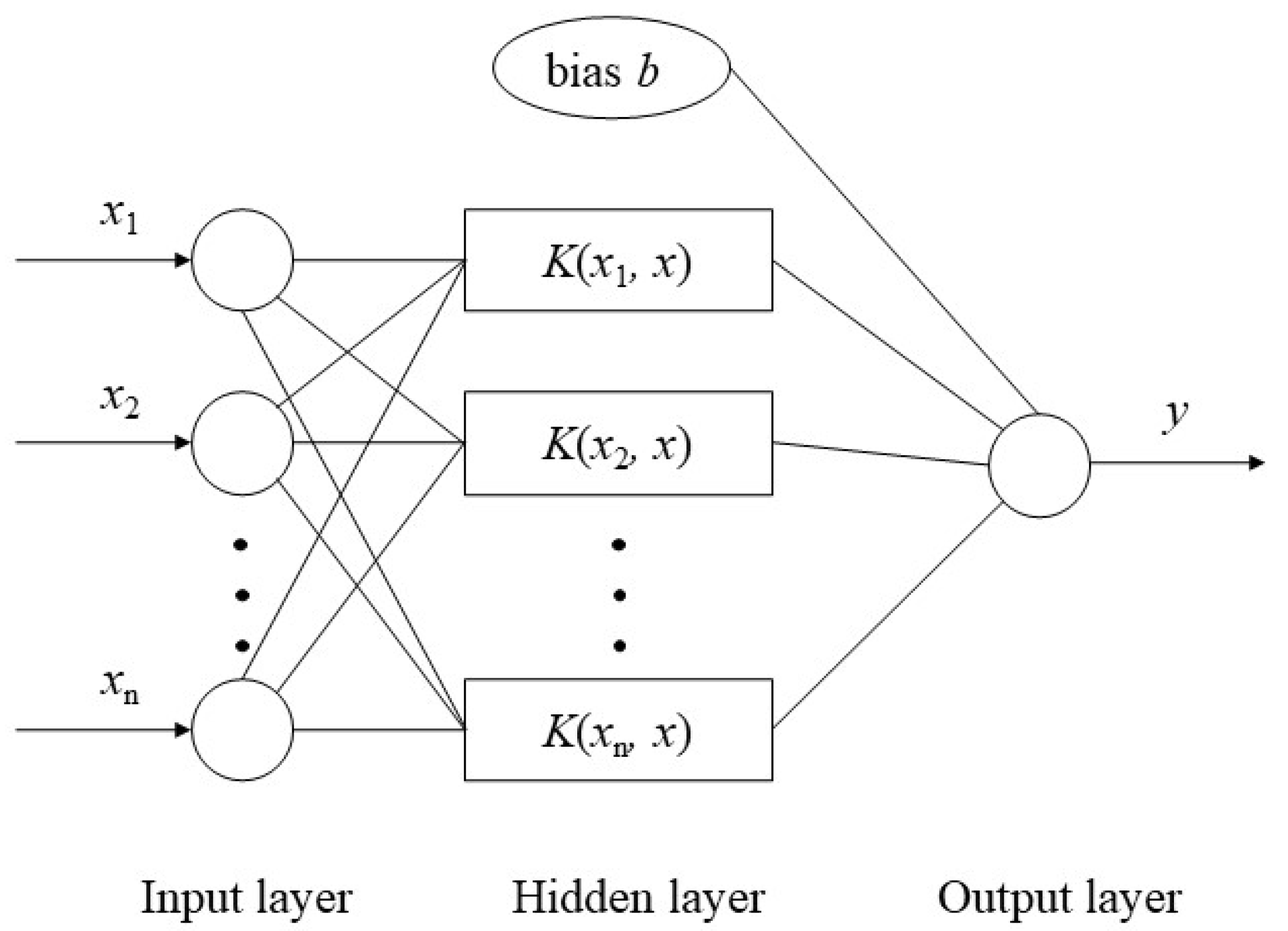

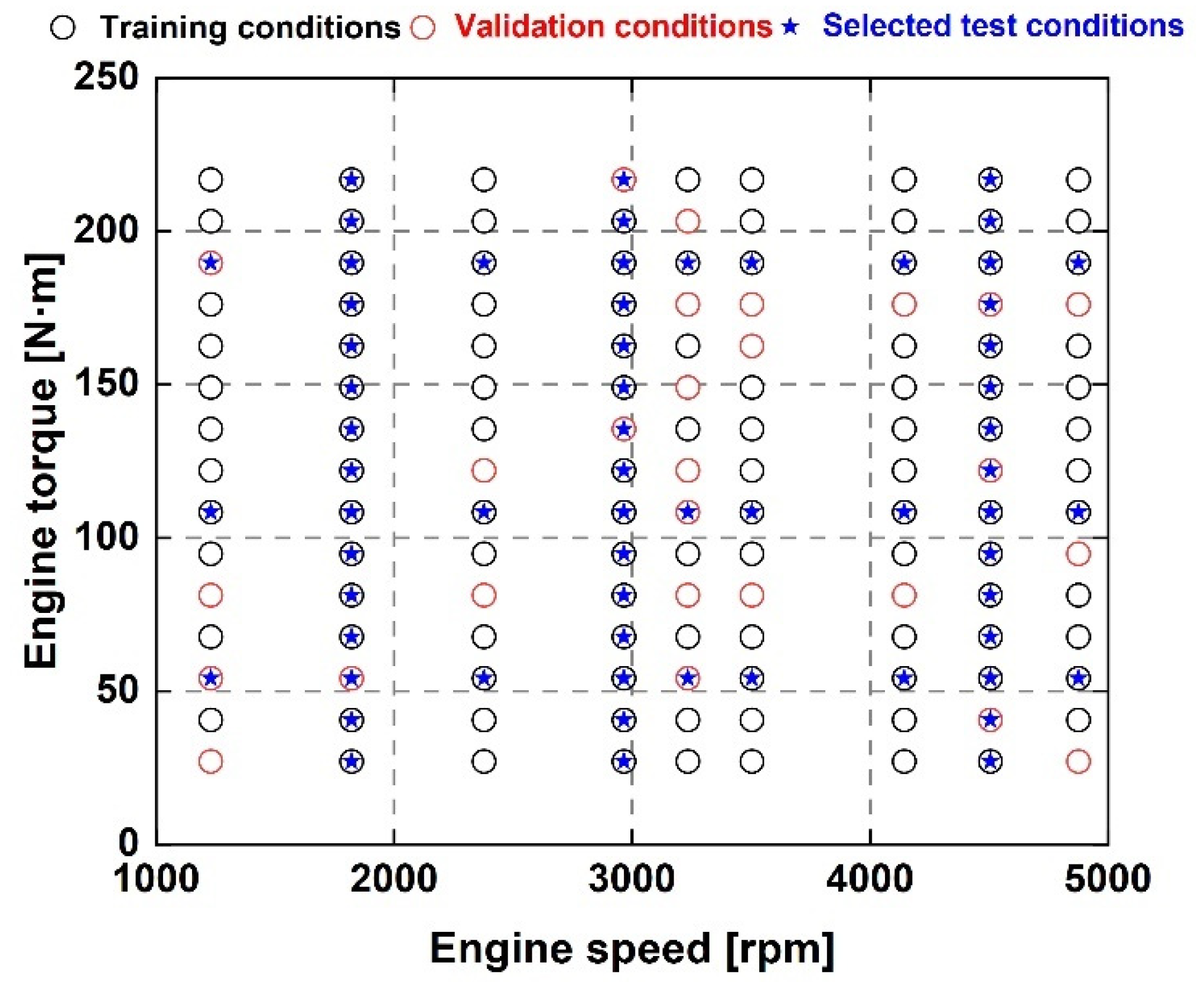
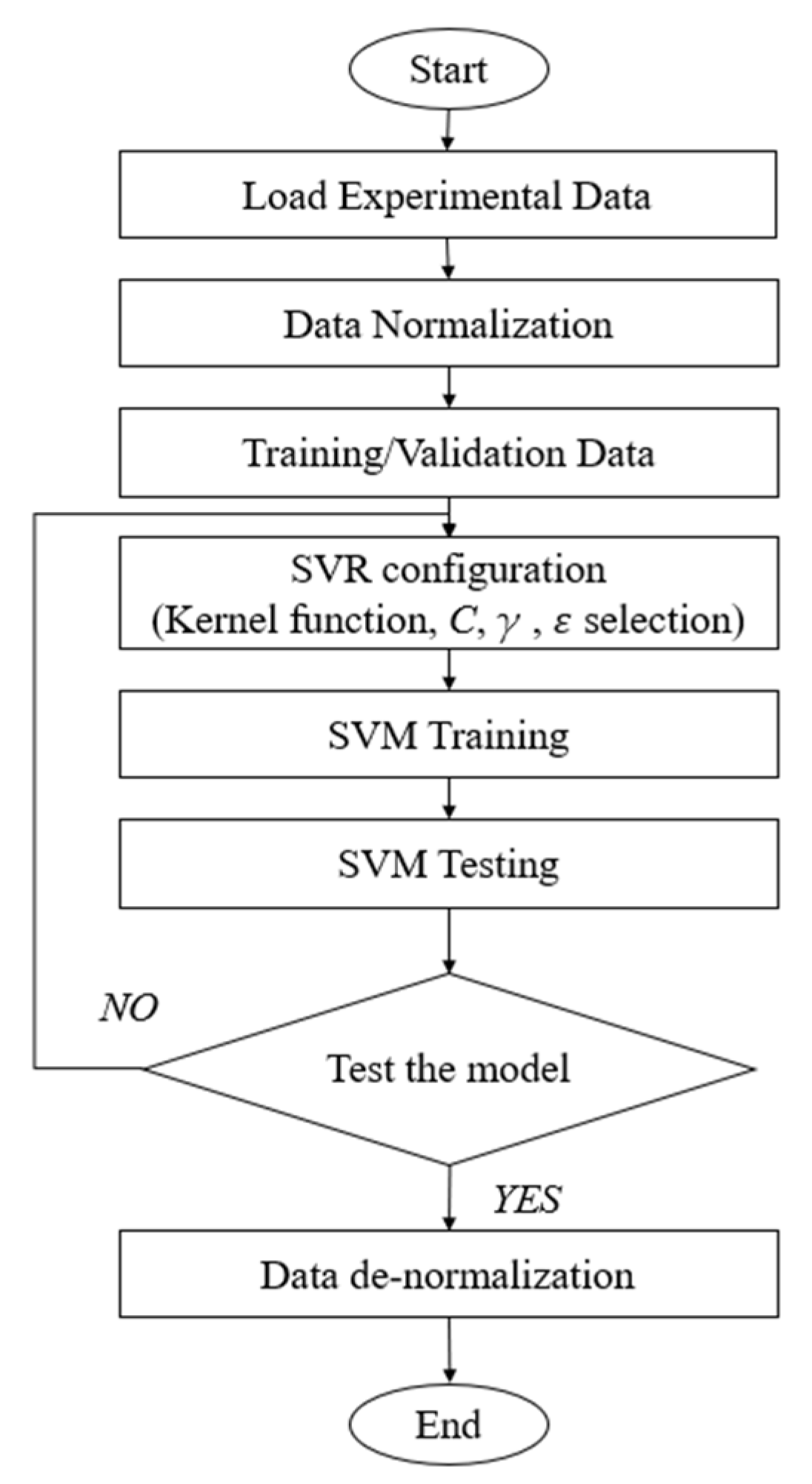
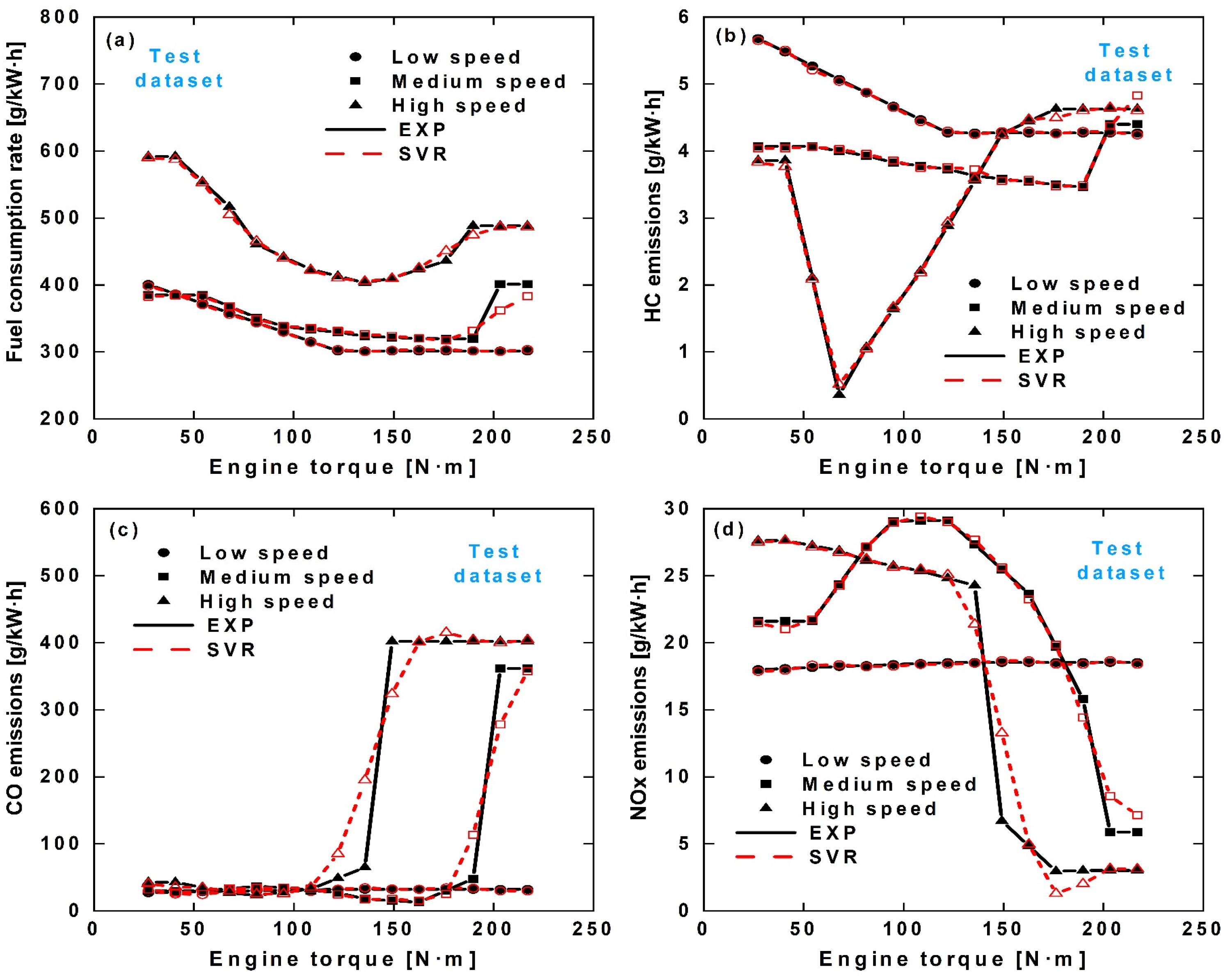
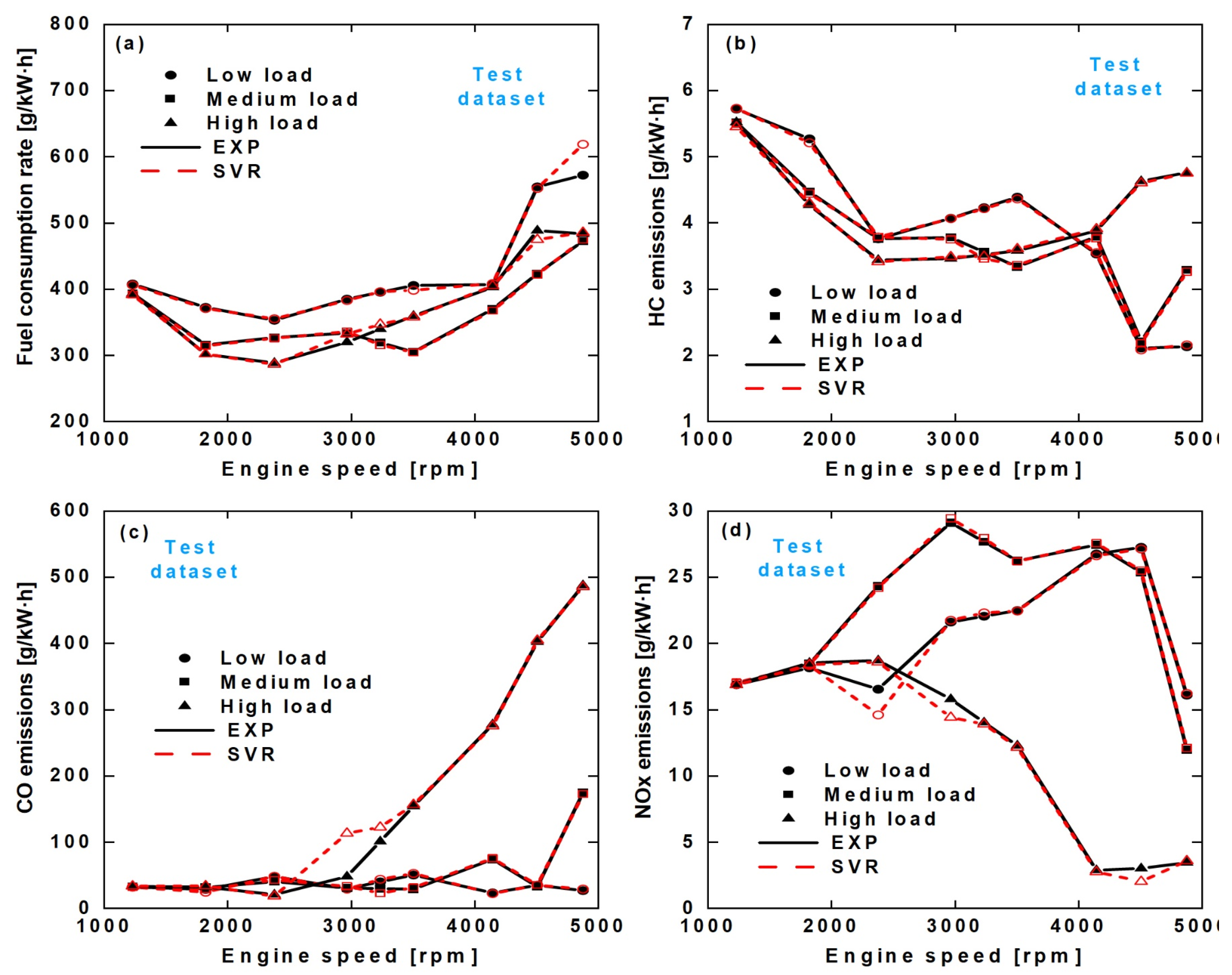
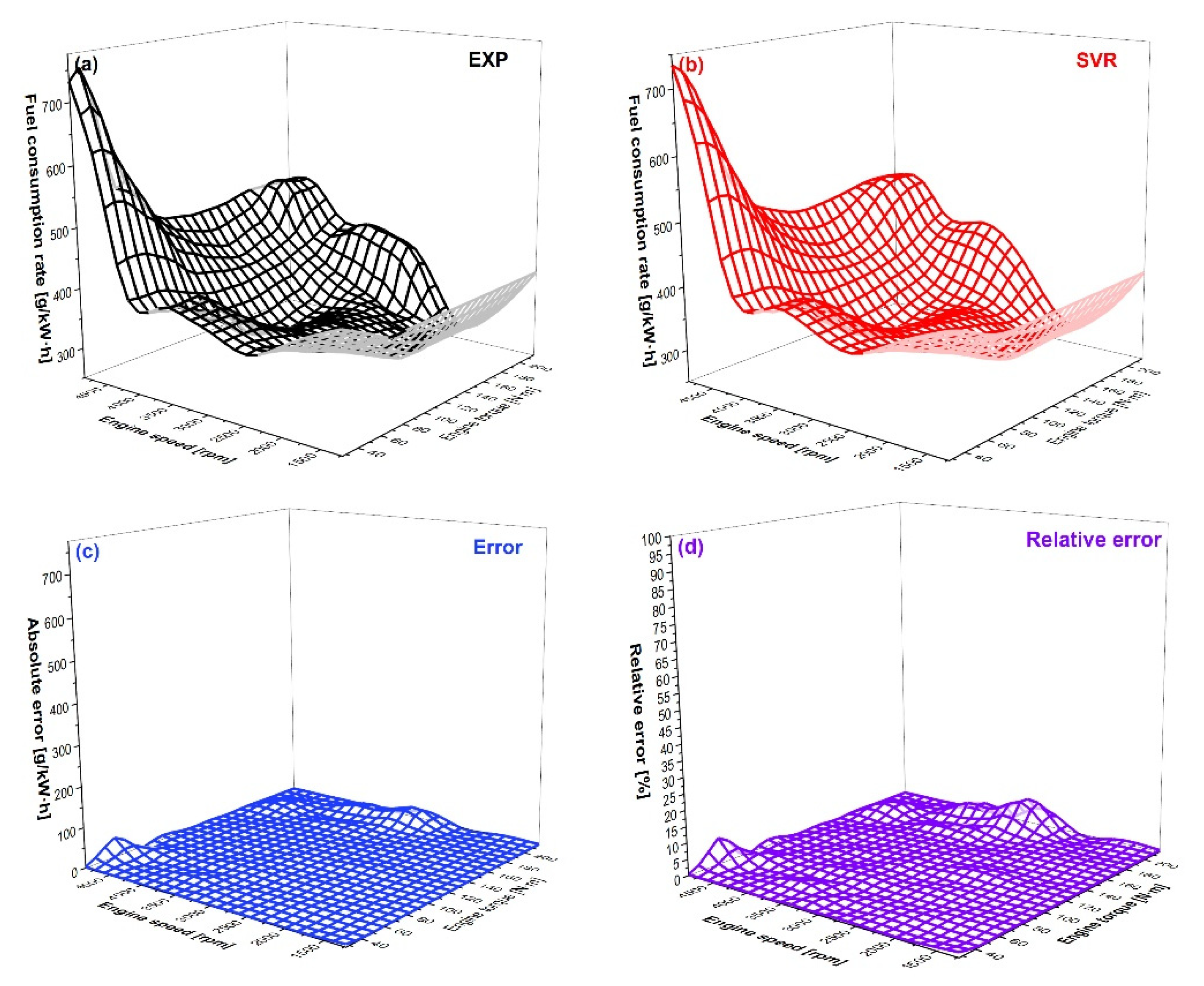
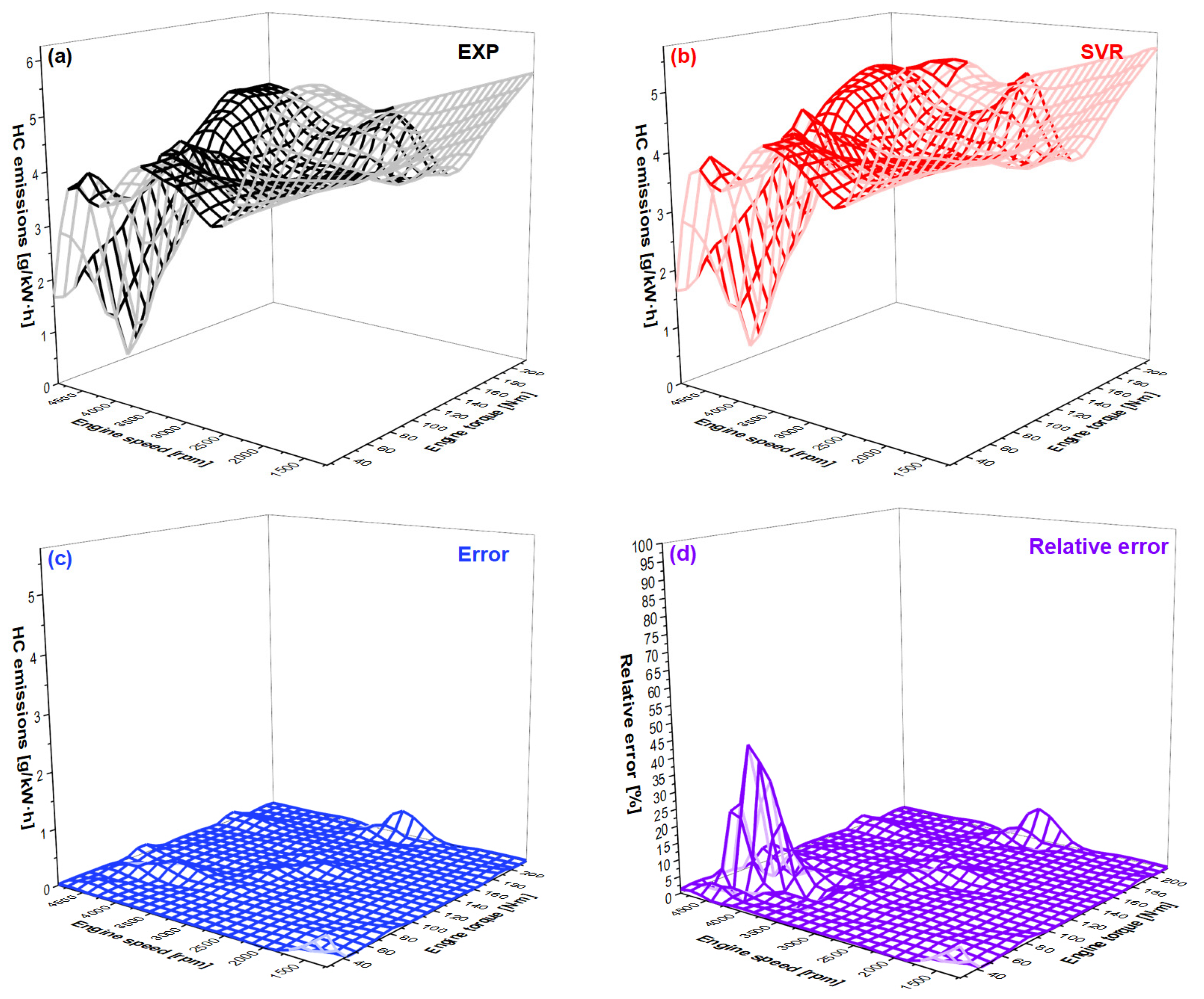
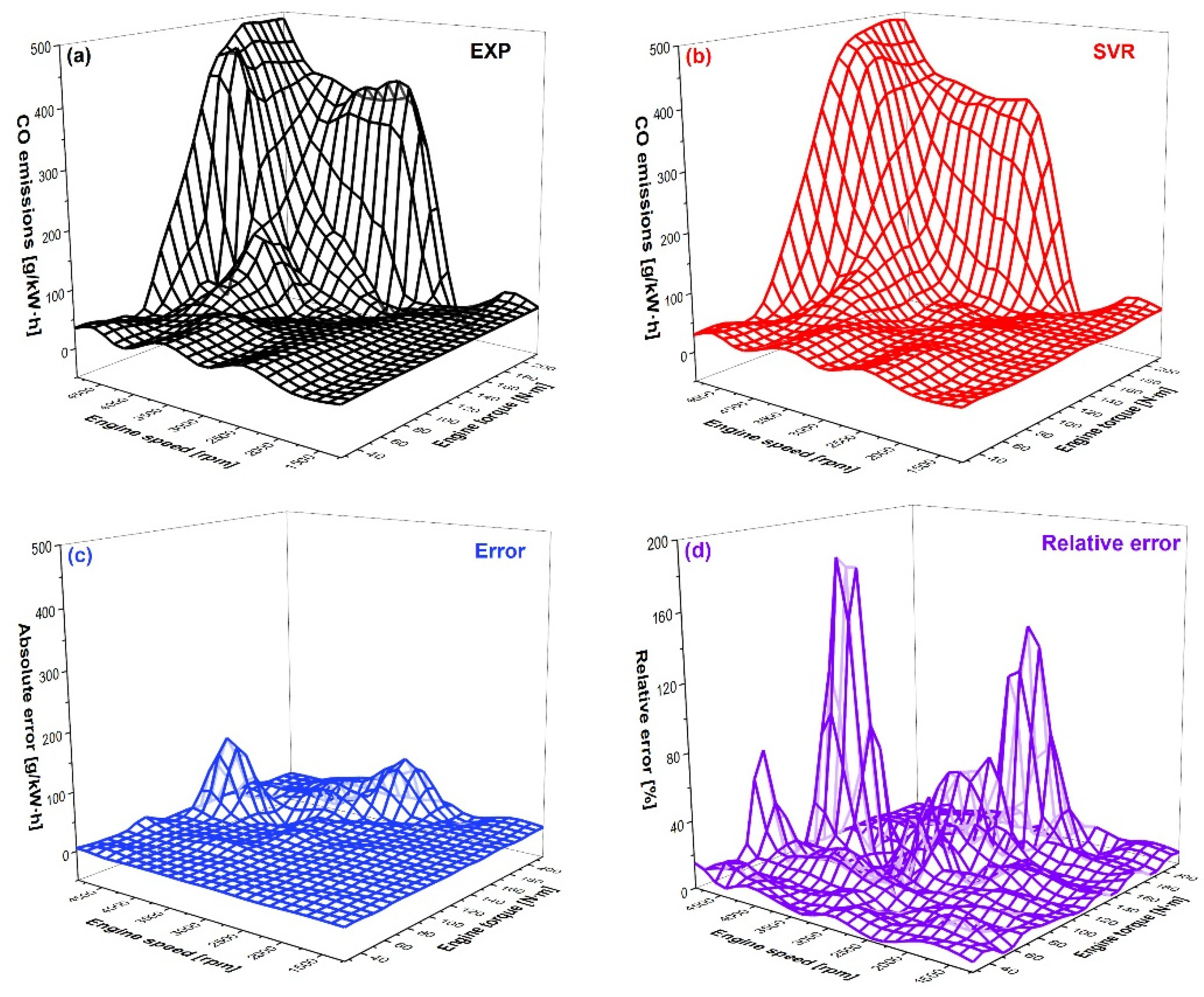

| Ref. | Engine Type | Method | Output | Performance |
|---|---|---|---|---|
| [35] | HCCI engine | ANN | CO emissions | R2 = 0.96 |
| [26] | Blended fuel SI engine | SVR | BSFC | R2 = 0.92 |
| [36] | Marine diesel engine | SVR | BSFC | R2 = 0.97 |
| [37] | Natural gas SI engine | ANN | Maximum pressure rise rate | R2 = 0.97 |
| [38] | SI gasoline engine | ANN | CO emissions | R2 = 0.98 |
| [39] | SI gasoline engine | ANN | NOx emissions | R2 = 0.97 |
| [40] | RCCI engine | RF | Peak pressure | R2 = 0.95 |
| [27] | Natural gas SI engine | SVR | Indicated engine power | R2 = 0.98 |
| Engine type | V type 6-cylinder, four-stroke |
| Cooling type | water cooling |
| Ignition sequence | 1-4-5-2-3-6 |
| Engine capacity | 3.0 L |
| Maximum power/speed | 102 kW/4875 rpm |
| Maximum torque/speed | 217 N·m/4143 rpm |
Publisher’s Note: MDPI stays neutral with regard to jurisdictional claims in published maps and institutional affiliations. |
© 2022 by the authors. Licensee MDPI, Basel, Switzerland. This article is an open access article distributed under the terms and conditions of the Creative Commons Attribution (CC BY) license (https://creativecommons.org/licenses/by/4.0/).
Share and Cite
Zhang, Y.; Wang, Q.; Chen, X.; Yan, Y.; Yang, R.; Liu, Z.; Fu, J. The Prediction of Spark-Ignition Engine Performance and Emissions Based on the SVR Algorithm. Processes 2022, 10, 312. https://doi.org/10.3390/pr10020312
Zhang Y, Wang Q, Chen X, Yan Y, Yang R, Liu Z, Fu J. The Prediction of Spark-Ignition Engine Performance and Emissions Based on the SVR Algorithm. Processes. 2022; 10(2):312. https://doi.org/10.3390/pr10020312
Chicago/Turabian StyleZhang, Yu, Qifan Wang, Xiaofei Chen, Yuchao Yan, Ruomiao Yang, Zhentao Liu, and Jiahong Fu. 2022. "The Prediction of Spark-Ignition Engine Performance and Emissions Based on the SVR Algorithm" Processes 10, no. 2: 312. https://doi.org/10.3390/pr10020312
APA StyleZhang, Y., Wang, Q., Chen, X., Yan, Y., Yang, R., Liu, Z., & Fu, J. (2022). The Prediction of Spark-Ignition Engine Performance and Emissions Based on the SVR Algorithm. Processes, 10(2), 312. https://doi.org/10.3390/pr10020312







